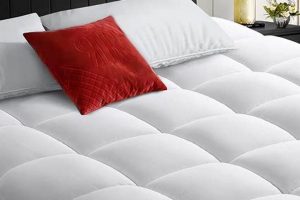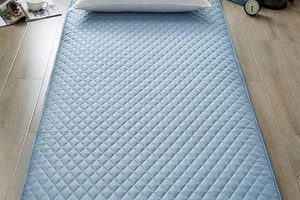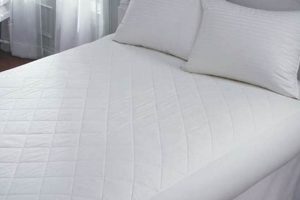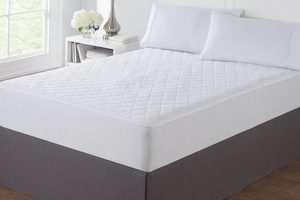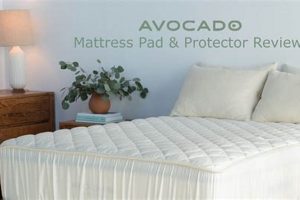A specialized layer designed to enhance the comfort and longevity of a memory foam mattress, this product serves as a protective barrier. It typically consists of materials such as cotton, polyester blends, or memory foam itself, and is placed atop the mattress before the fitted sheet. This addition aims to provide a softer sleeping surface, regulate temperature, and guard against spills, stains, and general wear and tear.
The inclusion of such an item can significantly influence the overall sleep experience. It offers an opportunity to customize the feel of the mattress, addressing concerns such as excessive firmness or heat retention. Furthermore, by shielding the mattress from direct contact with body oils and environmental factors, it contributes to maintaining hygiene and extending the lifespan of the underlying foam. Historically, these accessories have evolved from simple quilted covers to technologically advanced solutions incorporating cooling gels and moisture-wicking fabrics.
The following sections will delve into the various types available, factors to consider when selecting one, and best practices for maintenance and care to ensure optimal performance and durability.
Guidance on Mattress Pad Selection
This section offers insights into selecting a compatible layer to complement a temperature-sensitive, conforming mattress. Consideration of specific features is crucial to optimize sleep quality and mattress preservation.
Tip 1: Prioritize Breathability: Memory foam tends to retain heat. Opt for a pad constructed from breathable materials like cotton or bamboo to promote airflow and minimize overheating.
Tip 2: Assess Thickness and Firmness: The thickness of the pad influences the overall feel of the sleep surface. A thinner pad provides minimal cushioning, while a thicker pad significantly alters the firmness. Align the thickness with desired comfort level.
Tip 3: Evaluate Material Composition: Various materials offer distinct benefits. Memory foam pads enhance the conforming properties, while down alternative pads offer a plush feel. Consider individual preferences and potential allergies.
Tip 4: Consider Waterproofing Needs: If protection against spills and accidents is a primary concern, select a waterproof or water-resistant pad. Ensure the waterproof membrane is breathable to avoid trapping heat.
Tip 5: Verify Secure Fit: A well-fitting pad stays securely in place. Look for features such as elastic straps or deep pockets to accommodate the mattress depth and prevent slippage during sleep.
Tip 6: Review Washing Instructions: Regular cleaning is essential for maintaining hygiene. Choose a pad that is machine washable and dryer safe for convenient care.
Tip 7: Investigate Temperature Regulation Technologies: Seek out pads incorporating cooling technologies, such as gel infusions or phase-change materials, if minimizing heat retention is a priority.
Selecting the appropriate layer requires careful assessment of individual needs and preferences. By considering factors such as breathability, thickness, material composition, and waterproofing capabilities, a more comfortable and supportive sleep environment can be achieved.
The subsequent section will discuss cleaning and maintenance procedures to prolong the lifespan of both the mattress and its corresponding protective layer.
1. Breathability
Breathability is a critical factor when selecting a sleep surface enhancement, especially for use with conforming mattresses known for heat retention. The ability of a material to allow air circulation directly affects sleep comfort and overall sleep quality.
- Heat Dissipation and Regulation
Memory foam, by its nature, conforms closely to the body, which can restrict airflow and trap heat. A breathable pad facilitates heat dissipation, preventing overheating and maintaining a more consistent sleep temperature. For example, a cotton or bamboo pad allows for greater airflow compared to a pad made of synthetic materials like polyester.
- Moisture Wicking and Evaporation
Humans naturally perspire during sleep, and moisture buildup can create an uncomfortable sleep environment. Breathable materials promote moisture wicking, drawing sweat away from the body and allowing it to evaporate more readily. This reduces humidity and helps maintain a dry, comfortable sleep surface. A wool pad, for example, possesses inherent moisture-wicking properties.
- Material Composition and Construction
The breathability of a mattress pad is directly linked to its material composition and construction. Open-cell foam, natural fibers, and loose weaves promote greater airflow than closed-cell foam, synthetic materials, and tight weaves. For instance, a pad constructed with an open-weave cotton cover and a fill of shredded latex offers superior breathability compared to a pad with a quilted polyester cover and a solid memory foam core.
- Impact on Sleep Quality and Health
An unbreathable sleep surface can lead to discomfort, restlessness, and disrupted sleep. Chronic exposure to elevated temperatures during sleep may also negatively impact health. Selecting a breathable pad contributes to a more comfortable and restful sleep experience, potentially improving overall well-being. Individuals prone to night sweats or hot flashes particularly benefit from breathable bedding.
The interplay between these facets underscores the importance of breathability in selecting a mattress pad. By prioritizing materials and construction techniques that promote airflow, one can mitigate the heat retention associated with conforming mattresses and create a more comfortable and healthful sleep environment.
2. Thickness
The thickness of a mattress pad significantly influences the feel and performance of a memory foam mattress. As an intermediary layer between the sleeper and the mattress, its depth contributes directly to overall comfort and support characteristics.
- Altering Firmness Level
A thin pad, generally less than one inch, provides minimal cushioning and primarily serves as a protective barrier. Conversely, a thicker pad, exceeding two inches, considerably softens the mattress surface. The chosen thickness should align with desired firmness, either enhancing the existing feel or compensating for excessive firmness or softness in the underlying mattress. For example, someone finding their memory foam mattress too firm might benefit from a 3-inch plush pad.
- Impact on Pressure Relief
Memory foam is valued for its pressure-relieving properties. Adding a pad of varying thicknesses can either enhance or diminish this characteristic. A thinner pad may not noticeably i
mprove pressure relief, while a thicker, conforming pad can distribute weight more evenly, reducing pressure points. Individuals with joint pain may find a thicker pad offers superior comfort. - Effect on Temperature Regulation
The thickness of a mattress pad can indirectly influence temperature regulation. Thicker pads, particularly those made of dense materials, can trap heat, exacerbating the heat retention often associated with memory foam. Conversely, thinner pads or those constructed with breathable materials may minimize this effect. Consideration should be given to the climate and individual temperature preferences.
- Influence on Mattress Support
While a mattress pad primarily focuses on comfort, its thickness can subtly impact support. A very thick and unsupportive pad can create a sinking sensation, potentially compromising proper spinal alignment. Selecting a pad with appropriate density and support characteristics ensures that the benefits of the memory foam mattress are not negated. For example, a pad with a high-density foam core can provide both comfort and support.
These facets highlight the nuanced relationship between thickness and the performance of a memory foam mattress pad. Careful consideration of desired firmness, pressure relief, temperature regulation, and support ensures the selected pad complements the mattress and optimizes the sleep experience.
3. Material
The material composition of a mattress pad designed for use with memory foam mattresses directly influences its performance and suitability. Material selection affects factors such as breathability, temperature regulation, comfort, support, durability, and ease of maintenance. The inherent properties of different materials cause variations in heat retention, moisture wicking, and overall feel, thus impacting the sleep experience.
For instance, a mattress pad constructed from natural cotton or bamboo fibers offers enhanced breathability, mitigating the heat retention often associated with memory foam. Conversely, pads made from synthetic materials like polyester may trap heat, leading to discomfort. Memory foam pads, while conforming closely to the body, may exacerbate heat retention unless specifically designed with open-cell structures or gel infusions to improve airflow. Similarly, waterproof pads, typically incorporating a polyurethane layer, provide protection against spills but can compromise breathability if the membrane is not sufficiently permeable. The choice of material therefore dictates the pad’s ability to regulate temperature, wick away moisture, and maintain a comfortable sleeping environment.
Ultimately, the appropriate material for a mattress pad is contingent on individual needs and preferences. Consideration of factors such as climate, sensitivity to allergens, and desired level of support is essential. Selecting a material that complements the properties of the underlying memory foam mattress is crucial for optimizing sleep quality and maximizing the lifespan of both the pad and the mattress itself.
4. Waterproofing
Waterproofing is a significant consideration in the selection of a mattress pad, particularly for use with memory foam mattresses. The integration of a waterproof barrier aims to protect the underlying mattress from liquid damage, thereby extending its lifespan and maintaining its hygiene.
- Prevention of Liquid Intrusion
The primary function of a waterproof mattress pad is to prevent liquids, such as spills, sweat, or bodily fluids, from penetrating the mattress. Memory foam is susceptible to damage from moisture, which can lead to mold growth, bacterial proliferation, and structural degradation. A waterproof pad creates a barrier against these potential issues.
- Material Composition and Breathability Trade-off
Waterproof mattress pads typically employ a thin membrane, often made of polyurethane, laminated to a fabric surface. While effective in preventing liquid penetration, this membrane can restrict airflow, potentially exacerbating the heat retention associated with memory foam. Some manufacturers address this by utilizing breathable waterproof membranes or incorporating ventilation features into the pad’s design.
- Maintenance and Hygiene
A waterproof mattress pad simplifies cleaning and maintenance. Spills can be easily wiped away, preventing the need to clean the mattress itself. Regular washing of the pad helps to remove allergens and maintain a hygienic sleep environment. The waterproof layer provides an additional barrier against dust mites and other potential irritants.
- Impact on Comfort and Feel
The presence of a waterproof layer can subtly alter the feel of the mattress. Some individuals may find the membrane to be slightly stiff or crinkly. However, advancements in materials and construction have minimized these effects. The selection of a pad with a soft, flexible waterproof membrane can mitigate any potential compromise to comfort.
The decision to incorporate a waterproof feature into a mattress pad balances the need for mattress protection with the potential impact on breathability and comfort. A careful assessment of individual needs and preferences is essential to determine the suitability of a waterproof mattress pad for use with a memory foam mattress.
5. Secure Fit
Secure fit is a critical attribute of a mattress pad designed for use with a memory foam mattress. It directly influences the pad’s ability to provide consistent comfort, protection, and performance. A poorly fitting pad can shift during sleep, creating uneven surfaces and diminishing the intended benefits of both the pad and the underlying memory foam. This movement can lead to discomfort, disrupted sleep, and accelerated wear of both the pad and the mattress. As an example, a pad that slides off the edges of the mattress exposes the memory foam to direct contact with body oils and potential spills, negating the pad’s protective function.
The mechanism for achieving a secure fit typically involves elasticized corners, deep pockets, or adjustable straps. Deep pockets are designed to accommodate the thickness of the mattress, ensuring a snug fit around the perimeter. Elasticized corners provide a degree of stretch and grip, while adjustable straps allow for customization to various mattress depths. The selection of an appropriate secure fit mechanism depends on the specific dimensions of the mattress and the individual’s tolerance for adjustments. Failure to ensure a proper fit can result in bunching, wrinkling, and reduced effectiveness of the pad’s intended functions. Furthermore, continuous readjustment of a slipping pad disrupts sleep and diminishes the overall user experience.
In conclusion, secure fit is not merely an aesthetic consideration but an essential element of a high-performing mattress pad. A pad that remains securely in place throughout the night provides consistent comfort, protects the underlying memory foam from damage, and contributes to a more restful sleep experience. Addressing this aspect during the selection process is critical for realizing the full benefits of both the mattress and its
protective covering.
6. Maintenance
Effective maintenance is crucial for preserving the integrity and extending the lifespan of a mattress pad designed for use with a memory foam mattress. Regular care ensures optimal performance, hygiene, and longevity of both the pad and the underlying mattress.
- Regular Washing
Routine washing is essential for removing accumulated sweat, body oils, dust mites, and allergens. Failure to wash the pad periodically can lead to the build-up of these substances, compromising hygiene and potentially triggering allergic reactions. The frequency of washing depends on individual usage patterns and environmental factors, but generally, washing every one to two months is recommended. Refer to the manufacturer’s instructions for specific washing guidelines, as improper cleaning can damage the pad’s materials or construction. Using mild detergents and avoiding harsh chemicals such as bleach is advisable.
- Spot Cleaning
Prompt spot cleaning is necessary to address spills and stains as they occur. Allowing liquids to penetrate the pad can result in permanent staining and potential damage to the underlying mattress. Use a clean, damp cloth and a mild cleaning solution to gently blot the affected area. Avoid rubbing vigorously, as this can spread the stain or damage the pad’s fabric. Ensure the area is thoroughly dried after spot cleaning to prevent the growth of mold or mildew.
- Proper Drying Techniques
Following washing or spot cleaning, proper drying is crucial. Air drying is generally recommended to prevent shrinkage or damage to the pad’s materials. If using a machine dryer, select a low heat setting. Avoid over-drying, as this can weaken the fibers and reduce the pad’s lifespan. Ensure the pad is completely dry before placing it back on the mattress to prevent moisture build-up and potential mold growth.
- Storage Considerations
When not in use, proper storage is essential to protect the mattress pad from damage. Store the pad in a clean, dry environment, away from direct sunlight and extreme temperatures. Avoid folding the pad tightly, as this can create creases and compress the filling materials. Storing the pad in a breathable bag or container can help to prevent dust accumulation and maintain its freshness.
These maintenance practices are integral to preserving the functional integrity of a mattress pad designed for use with a memory foam mattress. Consistent adherence to these guidelines ensures a hygienic, comfortable, and long-lasting sleep surface, maximizing the benefits of both the pad and the underlying memory foam.
Frequently Asked Questions
This section addresses common inquiries regarding the selection, use, and maintenance of a mattress pad designed for use with memory foam mattresses.
Question 1: How does the material of a mattress pad affect its suitability for a Tempurpedic mattress?
The material composition directly influences breathability, temperature regulation, and overall comfort. Memory foam tends to retain heat; therefore, materials like cotton, bamboo, or open-cell foam are often preferred for their enhanced airflow properties. Synthetic materials, such as polyester, may exacerbate heat retention. Careful consideration of material characteristics is essential for optimizing the sleep experience.
Question 2: What is the optimal thickness for a mattress pad intended for use with a memory foam mattress?
The ideal thickness depends on individual preferences and the existing firmness of the mattress. A thinner pad (less than 1 inch) provides minimal cushioning and primarily serves as a protective barrier. A thicker pad (over 2 inches) significantly alters the feel of the mattress, potentially softening it. The selected thickness should complement the existing mattress firmness and address individual comfort needs.
Question 3: Is a waterproof mattress pad necessary for a Tempurpedic mattress?
A waterproof pad offers protection against spills and bodily fluids, which can damage memory foam. However, waterproof membranes may reduce breathability. If waterproofing is a priority, select a pad with a breathable waterproof membrane or ventilation features to mitigate heat retention.
Question 4: How can a secure fit be ensured when selecting a mattress pad?
Look for features such as elasticized corners, deep pockets, or adjustable straps. Deep pockets should accommodate the mattress thickness, ensuring a snug fit around the perimeter. A secure fit prevents the pad from shifting during sleep, maintaining consistent comfort and protection.
Question 5: How frequently should a mattress pad be washed?
Washing frequency depends on individual usage and environmental factors. Generally, washing every one to two months is recommended to remove accumulated sweat, body oils, dust mites, and allergens. Refer to the manufacturer’s instructions for specific washing guidelines.
Question 6: What are the best practices for drying a mattress pad after washing?
Air drying is generally recommended to prevent shrinkage or damage to the pad’s materials. If using a machine dryer, select a low heat setting and avoid over-drying. Ensure the pad is completely dry before placing it back on the mattress to prevent moisture build-up.
Careful consideration of these questions will aid in the selection and maintenance of a mattress pad that effectively enhances the comfort, protection, and longevity of a memory foam mattress.
The concluding section will summarize key takeaways and offer final recommendations.
Conclusion
The preceding analysis has explored the multifaceted considerations surrounding a mattress pad for Tempurpedic mattress applications. Key factors examined encompass material composition, thickness, waterproofing, secure fit, and maintenance protocols. A thorough understanding of these elements facilitates informed decision-making, allowing for optimized comfort, protection, and longevity of both the pad and the underlying mattress. Prioritizing breathability, selecting appropriate thickness, and ensuring a secure fit are crucial steps in maximizing the sleep experience.
The selection and proper maintenance of a compatible sleep surface enhancement represents a significant investment in long-term sleep quality and mattress preservation. Continued vigilance in adhering to recommended care practices will ensure the continued performance and benefits derived from the selected product, contributing to improved rest and overall well-being.


![Top Rated: Best Mattress Pad for Back Pain Relief [Guide] Organic & Natural Mattress Buyer’s Guide: Non-Toxic Sleep Solutions Top Rated: Best Mattress Pad for Back Pain Relief [Guide] | Organic & Natural Mattress Buyer’s Guide: Non-Toxic Sleep Solutions](https://mattressworldpa.com/wp-content/uploads/2025/07/th-4688-300x200.jpg)
